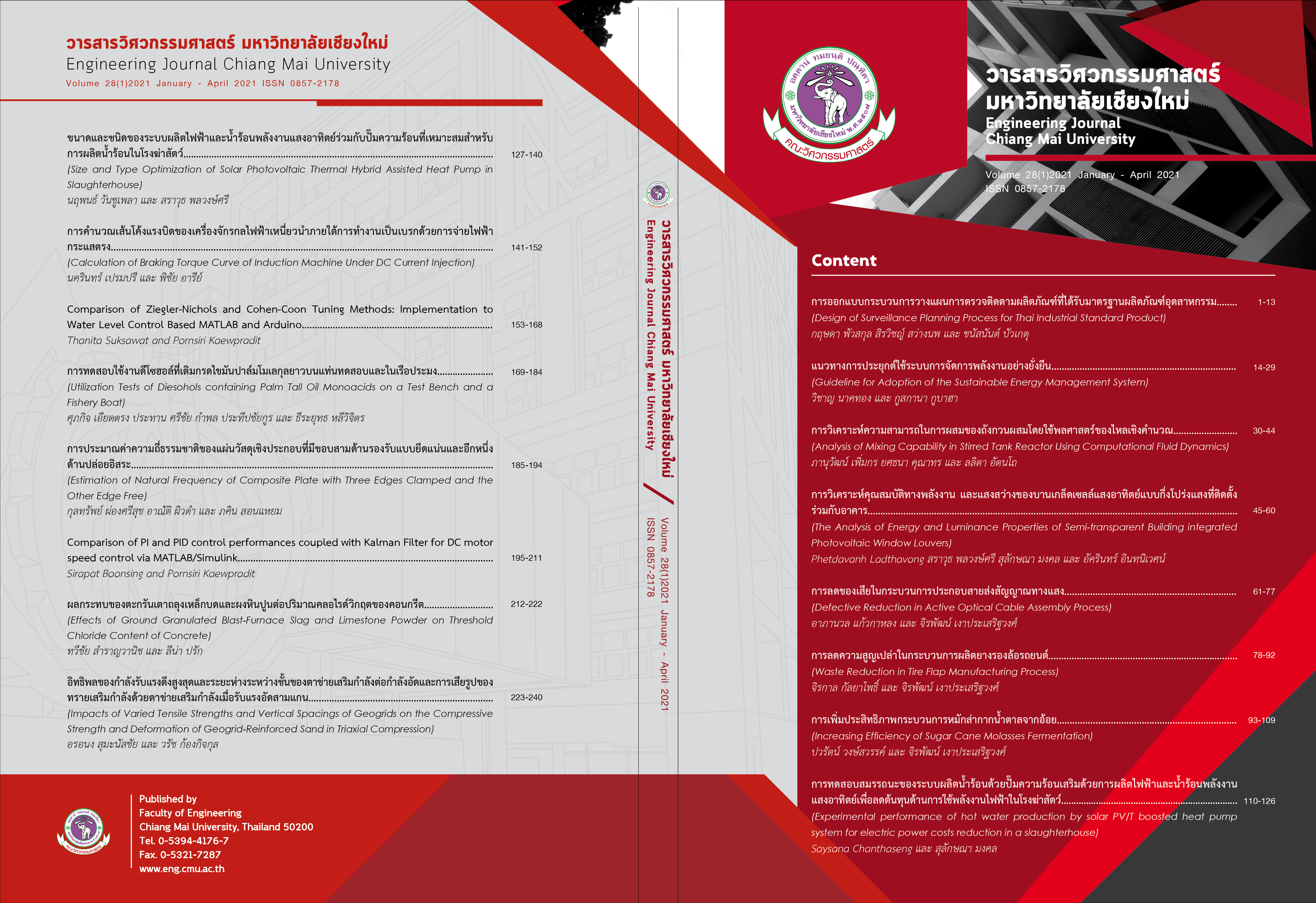Impacts of Tensile Strength and Spacing of Geogrids on the Compressive Strength and Deformation of Reinforced Sand in Triaxial Compression
Keywords:
Ultimate tensile strength, Spacing, Geogrid, Compressive strength, Deformation, Reinforced sandAbstract
Behaviours of reinforced soil are affected by the ultimate tensile strength (Tult) of geogrid and the vertical spacing (Sv) of arrangement. Basically, the concept inferred from the current design approach of a reinforced-soil retaining wall shows that, if the Tult-to-Sv (or TVR) ratio is kept the same, the outcoming performance is also the same. In this research, a series of triaxial compression tests was performed with sand either unreinforced or reinforced with polypropylene geogrids having four different Tult values. Number of geogrid layers and Sv were adjusted so as to obtain three different TVR values. Effects of varying Tult and TVR values were studied by comparing the compressive strength (Rmax) and Poisson’s ratio (nsec) among different geogrid-reinforced sand samples. From the results of this study, the followings are found. By comparing at the same TVR, the Rmax decreases, while the nsec increases or the lateral deformation increases, with increasing Tult. This implies that the performance of reinforcing with the geogrids having lower Tult but are closely spaced is better than that of reinforcing with the geogrids having higher Tult but are coarsely spaced. On the other hand, when comparing at the same Tult, the Rmax increases, while the nsec decreases, with increasing TVR, because of the increasing of reinforcing density. The influences of Tult and TVR on the Rmax and nsec can be explained by the development of deterministic zone resulted from no connection between the geogrid and facing at the end, which negatively affect the transferring of the tensile force mobilised in the geogrid to additional confining pressure to sand.
References
Nicks, J. E., Adams, M., Ooi, P. and Stabile, T. Geosynthetic Reinforced Soil Performance Testing -Axial Load Deformation Relationships. FHWA-HRT-13-066, 2013.
Pham, T.Q. Investigating Composite Behavior of Geosynthetic Reinforced Soil (GRS)Mass. Ph.D. Thesis, University of Colorado, Denver, USA, 2009.
Nawir, H., Tatsuoka, F. and Kuwano, R. Experimental Evaluation of the Viscous Properties of Sand in Shear. Soils and Foundations, 2003,43(6): 13-31.
ASTM D7181-20.Standard Test Method for Consolidated Drained Triaxial Compression Test for Soils. ASTM International, West Conshohocken, PA, 2020.
Miura, S. and Toki, S. A Sample Preparation Method and Its Effect on Static and Cyclic Deformation-Strength Properties of Sand. Soils and Foundations, 1982;22(1):61-77.
Kongkitkul, W., Tatsuoka, F. and Hirakawa, D. Effects of Reinforcement Type and Loading History on the Deformation of Reinforced Sand in Plane Strain Compression. Soils and Foundations, 2007;47(2):395-414.
Kongkitkul, W. Effect of Material Viscous Properties on the Residual Deformation of Geosynthetic-Reinforced Sand. Ph.D. Thesis, Department of Civil Engineering, University of Tokyo, Japan,2004.
Tatsuoka, F. An Approximate Isotropic Perfectly Plastic Solution for Compressive Strength of Geosynthetic-Reinforced Soil. Geosynthetics International, 2004;11(5): 390-405.
สุรพันธ์ สุดใจ และ วรัช ก้องกิจกุล. ผลกระทบของอัตราส่วนปกคลุมและระยะระหว่างชั้นของตาข่ายเสริมกำลังแบบสองทิศทางที่มีต่อกำลังอัดของทรายเสริมกำลัง.วารสารวิศวกรรมศาสตร์มหาวิทยาลัยเชียงใหม่, 2563; 27(1): 198-211.
Shen, P., Han, J., and Xu, C. Numerical Investigation of Reinforcement Pullout Resistance Effects on Behavior of Geosynthetic-Reinforced Soil (GRS) Piers. Geotextiles and Geomembranes, 2019;49(3): 564-578.
Tatsuoka, F. Geosynthetic-Reinforced Soil Structures for Railways and Roads: Development from Walls to Bridges. Innovative Infrastructure Solutions, 2019; 4:49-67.
Kongkitkul, W., Tatsuoka, F. and Hirakawa, D. Rate-Dependent Load-Strain Behaviour of Geogrid Arranged in Sand Under Plane Strain Compression. Soils and Foundations, 2007;47(3): 473-491.
Downloads
Published
Issue
Section
License
ลิขสิทธิ์ของบทความที่ตีพิมพ์ในวารสารฉบับนี้จะยังเป็นของผู้แต่งและยินยอมให้สิทธิ์เผยแพร่กับทางวารสาร
การเผยแพร่ในระบบวารสารแบบเปิดนี้ บทความจะสามารถนำไปใช้ได้ฟรีในการศึกษา และในทางที่ไม่เกี่ยวกับการค้า




